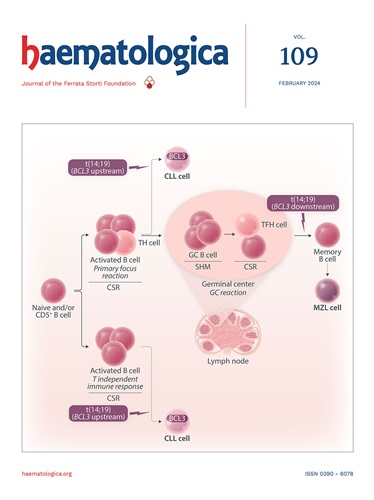Aging-declined RNA exportation impairs hematopoietic stem cells by inducing R-loop.
IF 8.2
1区 医学
Q1 HEMATOLOGY
引用次数: 0
Abstract
Aging-related accumulation of DNA damage adversely affects hematopoietic stem cell (HSC). However, the mechanisms underlying this accumulation and strategies for its elimination to rejuvenate aged HSCs remain largely obscure. This study uncovers a notable surge in R-Loop presence within aged HSCs, notably co-localized with γH2AX and RPA (Replication Protein A), and correlated with RNA residency in the nucleus. Targeted induction of R-Loop impairs the function of HSCs. Mechanistically, RNA exportation is compromised in aged HSCs due to a decline in Alyref, the primary constituent of the TREX (transcription-export complex). Specifically, Alyref dysfunction results in RNA retention within the nucleus, mimicking the functional characteristics of aged HSCs. The nuclear accumulation of RNA leads to the formation of RNA:DNA hybrids, known as R-Loop structures, consequently inducing replication stress and DNA damage. Introducing a quantitative boost of Alyref in aged HSCs notably reinstates RNA transportation, diminishes R-Loop formation and replication stress, and ultimately enhances the performance of aged HSCs. Taken together, our research demonstrates the initial revelation that aging-triggered replication stress stems from abnormal RNA transportation-propelled R-Loop configurations, hinting at the potential of quantitatively modulating RNA transportation to mitigate the physiological drawbacks of aging on HSCs.衰老减少的RNA输出通过诱导R-loop损害造血干细胞。
衰老相关的DNA损伤积累会对造血干细胞(HSC)产生不利影响。然而,这种积累的机制和消除其使衰老hsc恢复活力的策略在很大程度上仍然不清楚。这项研究发现,在衰老的hsc中,R-Loop的存在显著增加,特别是与γH2AX和RPA(复制蛋白a)共定位,并与RNA在细胞核中的驻留相关。靶向诱导R-Loop会损害造血干细胞的功能。从机制上讲,由于TREX(转录输出复合体)的主要成分Alyref的下降,衰老的hsc中的RNA输出受到损害。具体来说,Alyref功能障碍导致RNA滞留在细胞核内,模仿衰老hsc的功能特征。RNA的核积累导致RNA:DNA杂交体的形成,称为R-Loop结构,从而诱导复制应激和DNA损伤。在衰老的hsc中引入Alyref可显著恢复RNA运输,减少R-Loop的形成和复制应激,最终提高衰老hsc的性能。综上所述,我们的研究初步揭示了衰老引发的复制应激源于异常RNA运输推动的R-Loop配置,这暗示了定量调节RNA运输以减轻hsc衰老生理缺陷的潜力。
本文章由计算机程序翻译,如有差异,请以英文原文为准。
求助全文
约1分钟内获得全文
求助全文
来源期刊

Haematologica
医学-血液学
CiteScore
14.10
自引率
2.00%
发文量
349
审稿时长
3-6 weeks
期刊介绍:
Haematologica is a journal that publishes articles within the broad field of hematology. It reports on novel findings in basic, clinical, and translational research.
Scope:
The scope of the journal includes reporting novel research results that:
Have a significant impact on understanding normal hematology or the development of hematological diseases.
Are likely to bring important changes to the diagnosis or treatment of hematological diseases.
 求助内容:
求助内容: 应助结果提醒方式:
应助结果提醒方式:


